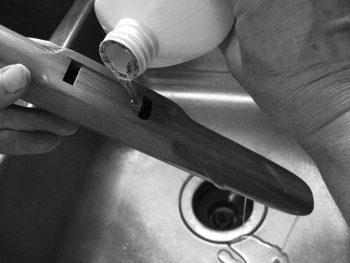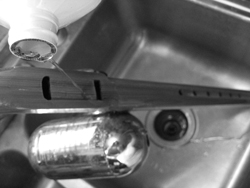|
Why to Oil
1. Helps Prevent
Cracking
When you oil the interior of your flute it acts as a partial
barrier to help prevent your saliva from penetrating the wood.
2. Helps Air
Flow
When wood is dry it adds a resistance to the air flow.
What Type
of Oil
We use mineral oil. Mineral Oil can be bought in any pharmacy
section or drug store. You will find it in the laxative section.
We do not use tung oil or vegetable oil so we can not recommend
it.
When and How to Oil
BEFORE you oil, make sure that the wood is dry and your flute
has not been played for a few hours. We recommend that you rub
a few drops of oil into the flue area, on the cutting edge and
around the finger holes every 3rd or 4th time that you play.
Oiling frequency depends on how dry your flute is. Oiling the
finger holes will help you form a seal on them with the pads
of your fingers. It's a great help to beginner players.
Oil the Air Chambers
How Often? Every 2-4 Weeks.
 |
To Prevent
Cracking
We recommend that if you plan on playing 15 minutes or more at
a time, coat the inside of the Air Chambers with oil. This will
minimize the absorption of your saliva by the wood inside the
chambers. Take the block off of your flute. Pour the oil directly
into the hole until you see it run out of the mouth piece. Rotate
your flute in a circle to make sure that the oil coats the entire
inside of the air chambers. Wipe off any excess oil with a cloth.
Replace your block. Blow several quick hard breaths into your
flute. This will push out any loose oil. Slide the block back
and wipe away the loose oil from your flue area. How often you
oil the air chambers depends on how often you play your flute.
You don't have to do this very often. Every 2-4 weeks should
be sufficient.
Oil Entire Flute
How Often? Once a Year.
 |
Give your flute
a thorough oiling once a year. If you live in a very dry climate
you may need to do this more often. Your flute will begin to
sound breathy and hissy when it is dry.
Once a year or
so, flip your flute around and pour oil in the other hole. Rotating
the flute around in a circle to ensure that the entire inside
of the flute gets a good coating of oil. Wipe oil all over the
outside of your flute with a cloth. Stand your flute up in the
sink and let the oil drain out for several hours.
Weather Cautions
Climate Changes
Do not expose your flute to sudden extreme temperature or climate
changes (heat,cold,wet,dry). Wood is very sensitive to the elements.
Under normal use, your flute will not crack. However, do not
to subject the wood to quick temperature and climate changes.
Always warm your flute before playing. A cold instrument will
condense your warm breath faster than a warm one. A cold instrument
being warmed by playing will also be unstable in pitch while
warming. Warm the instrument slowly by holding it in your hands
or under your arm. Playing a wood instrument outdoors on a cold
day is not recommended. The hot breath passing through the wood
will make too drastic a change in temperature in too short of
a time resulting in sudden contraction of the wood - instant
crack!
Avoid Storing
Flute in Drafts
The moving air originating from an open window, electric fan,
or air-conditioner will quickly dry out your flute and increase
the risk of cracking.
Avoid Storing
Flute in Direct Sunlight
A flute stored so that the direct rays of the sun hit it runs
the risk of cracking.
Stains
Do not let lipstick or ink come into contact with your flute.
Wood is very absorbent. A permanent stain will result if your
flute is used by a player wearing lipstick. Ink from a fountain
pen or ball-point pen will also leave permanent marks on your
flute. |

